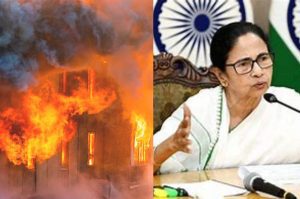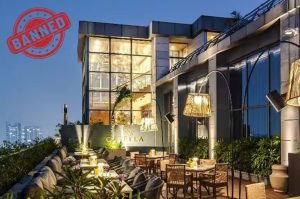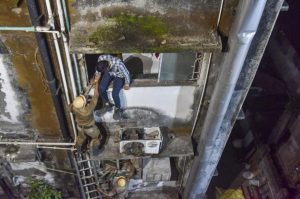West Bengal Fire Safety: Following the April 29, 2025, Burrabazar hotel fire that killed 14, the West Bengal government released 20-point fire safety guidelines to prevent future tragedies. Here’s an in-depth look at the incident, new policies, and what they mean for urban safety.
West Bengal Fire Safety: A Tragedy That Shook Kolkata
In the aftermath of one of the deadliest urban fire incidents in Kolkata’s recent history, the West Bengal government has issued a sweeping 20-point guideline designed to overhaul fire safety across the state. The April 29, 2025, fire at the Rituraj Hotel in Burrabazar claimed the lives of 14 people and left 13 others severely injured. The blaze, which broke out in the congested heart of the city around 7:30 PM, exposed grave lapses in enforcement, infrastructure, and safety protocols.
Burrabazar, a century-old commercial hub, is no stranger to fire hazards. Yet the sheer scale of the Rituraj Hotel fire stunned residents and officials alike. As rescue workers battled flames and thick smoke, survivors recounted scenes of panic, blocked exits, and cries for help that went unanswered.
The incident has catalyzed both public outcry and political action. Within a week, the West Bengal Department of Urban Development and Municipal Affairs issued a formal memorandum outlining 20 crucial fire safety directives, many of which aim to address long-standing loopholes in building management, occupancy types, and emergency planning.
This article delves deep into the Burrabazar hotel fire, examines eyewitness accounts and administrative failures, and provides a comprehensive breakdown of the newly mandated West Bengal fire safety guidelines.
Background: What Happened at Rituraj Hotel, Burrabazar?
On the evening of April 29, thick smoke began billowing from the upper floors of Rituraj Hotel, a mid-rise commercial structure located in the densely packed Burrabazar area. Most of the hotel’s 60+ rooms were occupied by outstation traders, tourists, and workers.
With flammable materials like paper cartons and plastic containers stored in corridors and near staircases, the fire quickly spread to adjacent floors. Multiple witnesses said the fire alarms didn’t go off, and no sprinkler systems were operational at the time.
By the time the fire brigade arrived, the building was already engulfed in flames. Firefighters battled for over five hours to contain the inferno, working with limited access due to Burrabazar’s narrow lanes and parked vehicles blocking entry points.
The death toll included children, senior citizens, and two firefighters. Most deaths were attributed to asphyxiation from toxic smoke, as many guests were trapped in locked rooms or blocked stairwells.
Public and Political Outcry
The public reaction was one of shock, anger, and grief. Protests erupted outside the hotel and Kolkata Municipal Corporation (KMC) offices, with citizens demanding justice and accountability.
Chief Minister Mamata Banerjee visited the site and the injured at SSKM Hospital. In a press statement, she vowed strict action:
“Even if a people’s representative was involved, they will not be spared.”


Prime Minister Narendra Modi also expressed condolences and announced ex-gratia compensation for the families of the deceased. The Kolkata Police formed a Special Investigation Team (SIT) to probe the causes, lapses, and potential criminal negligence.
The 20-Point West Bengal Fire Safety Guidelines
On May 6, 2025, the Department of Urban Development and Municipal Affairs, West Bengal, released a 20-point fire safety guideline. These are intended to standardize safety features in both commercial and residential buildings, especially in high-density areas like Burrabazar.
Here is a detailed breakdown of the key components:
Rooftop Accessibility
- All rooftops must remain clear and accessible for evacuation.
- Rooftop partitions, illegal structures, and permanent lockups are banned.
Multiple Exit Routes
- Buildings must have at least two unobstructed exit routes.
- Staircases and corridors must remain open and illuminated.
Fire Doors and Smoke Barriers
- All staircases must be equipped with fire-rated doors to prevent smoke ingress.
- Automatic door closers and smoke containment barriers are mandatory.
Emergency Lighting
- Backup lighting systems must be installed in escape routes and lobbies.
Sprinkler Systems
- Mandatory sprinkler installation for all commercial and mixed-use buildings.
- Periodic maintenance must be certified annually.
Separate Staircases for Mixed-Use Buildings
- Residential and commercial portions of mixed-use buildings must have separate escape staircases.
Basement Safety
- A minimum of two exits required for basements.
- Storage of inflammable items such as chemicals or paper is strictly prohibited.
Fire Alarm and Detection
- Automated alarm systems with smoke detectors must be installed in all floors.
Fire Hose Reels and Hydrants
- Functioning hydrants and hose reels must be present in every corridor.
Electrical Audit Mandate
- Annual third-party electrical safety audits are now compulsory.
Generator Room Safety
- Generator rooms must be sealed, ventilated, and equipped with CO2 fire extinguishers.
Clear Signage
- Illuminated “Exit” signs must be installed at every evacuation point.
Refresher Training for Staff
- Building staff and security guards must undergo annual fire drill training.
Access for Emergency Vehicles
- Entry points to all buildings must allow access for fire engines and ambulances.
Legal Accountability
- Any deviation from these norms may result in license revocation and criminal charges.
Ban on Rooftop Bars Without License
- Rooftop restaurants and lounges now need special fire clearance from KMC.
Elevator Shaft Guidelines
- Elevators are not escape routes, but lobbies may be used if fire-rated and ventilated.
LPG Cylinder Usage in Hotels
- Use of LPG cylinders inside guest rooms is banned.
Fire Exit Mapping
- All buildings must display fire escape plans at each floor.
Periodic Inspections
- Surprise checks and quarterly audits will be conducted by fire officials.


Eyewitness Accounts: A Night of Horror
Many survivors who escaped the fire described terrifying scenes. Manish Sethi, a textile trader from Rajasthan, said:
“I saw people breaking windows to escape. The smoke was suffocating. No alarms. No lights. Just darkness and screams.”
Sohini Dey, who lost her husband in the fire, cried:
“He went back to get his wallet. If the stairs weren’t blocked, he could’ve survived.”
Firefighter Sanjay Das, who suffered second-degree burns, recalled:
“It was chaos. No water supply on the top floor. We had to carry hose pipes up manually. The building was a trap.”
Legal Actions and Arrests
Within days of the incident, authorities arrested:
- Hotel Manager – For violating fire safety norms and negligence
- Building Owner – For unauthorized rooftop structures and expired fire license
- KMC Inspector – Suspended for ignoring prior complaints
The Kolkata Police SIT is also investigating whether bribes were exchanged to overlook safety violations.
Political Fallout and Administrative Accountability
The opposition BJP and Congress blamed the ruling Trinamool Congress (TMC) for allowing illegal constructions and ignoring civic warnings.
CPI(M) leader Md. Salim called for an independent probe:
“This is not an isolated incident. The entire system is complicit.”
The KMC has since launched a citywide survey of rooftop bars, commercial hotels, and basements.
Broader Implications for Urban Safety
This tragedy and the West Bengal fire safety guidelines Burrabazar hotel fire case are now benchmarks for urban reform in Indian cities. Experts point out that nearly 60% of Kolkata’s old structures are vulnerable to fires due to outdated wiring, blocked exits, and poor planning.
Architect and urban planner Ruchira Sen stated:
“The tragedy reveals what happenssafety
when urban expansion outpaces safety mechanisms.”
NGOs are now lobbying for fire safety education in schools and public spaces, while online platforms are encouraging citizens to report unsafe buildings anonymously.
Conclusion: Turning Tragedy into Reform
The Rituraj Hotel fire was not just an accident—it was the result of systemic negligence. However, with the issuance of the new 20-point fire safety guideline, West Bengal has taken a significant step toward protecting its urban population.
But policies alone are not enough. Real change demands strict enforcement, public awareness, and political will. The lives lost in Burrabazar should not be in vain. They must serve as a reminder that human life cannot be compromised for profit or convenience.
Kolkata Municipal Corporation (KMC)
-
Official Website: https://www.kmcgov.in/KMCPortal/jsp/KMCPortalHome1.jsp
-
Online Services: https://www.kmcgov.in/KMCPortal/jsp/KMCBuildingPayment.jsp
-
Trade License Information: https://www.kmcgov.in/KMCPortal/jsp/KMCTradeLicenseHome.jsp
Government of West Bengal
-
Official Portal: https://wb.gov.in/
-
Egiye Bangla (Government Services Portal): https://www.egiyebangla.gov.in/
Ministry of Housing and Urban Affairs, Government of India
-
Official Website: https://mohua.gov.in/
-
National Portal of India: https://india.gov.in/official-website-ministry-housing-and-urban-affairs
Also read: Home | Channel 6 Network – Latest News, Breaking Updates: Politics, Business, Tech & More


